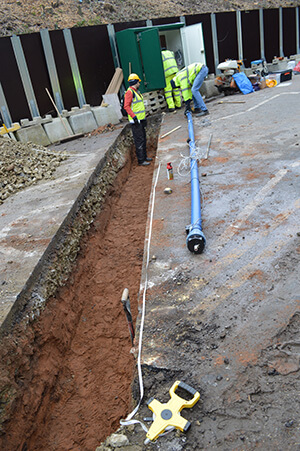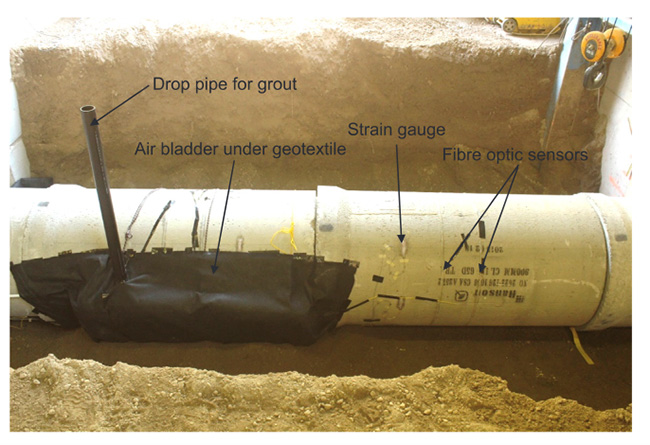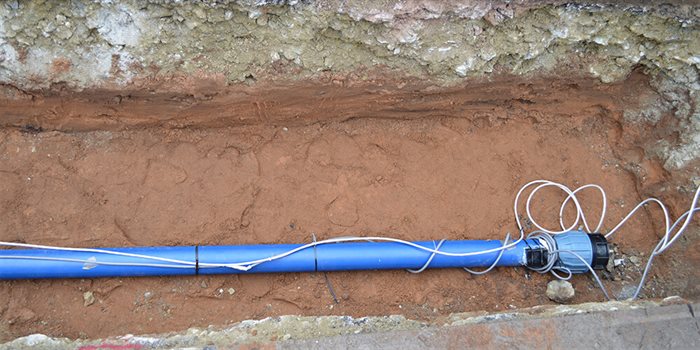The ground is vital for any civil engineering structure. It supports our above ground infrastructure through our foundations and the ground itself and it supports our buried infrastructure such as tunnels and pipes. The ground is a complex environment, and this applies especially to the soil - buried infrastructure – surface infrastructure system. Research in this field is ongoing and a few examples are listed below.
 We regularly dig up our roads to access our buried infrastructure for repair or replacements. This then intervenes with the road – ground – buried asset system and results in stress relieve of the soil. This in turn can cause displacements. When we fill the trenches or repair the potholes, the patches are never as good as the original road structure despite following specifications. Interfering in the road structure can impact of how the load from cars and lorries transfers into the ground and thus impacts on the pipes or how the water infiltrates into the ground through cracks thereby changing the water content of the soil impacting its strength. We have conducted work comparing different trenching practices on road deterioration during a controlled field experiment as part of the Assessing the Underworld project. This involved constructing two trenches, placing an instrumented pipe at the bottom of the trenches, and then reinstating the trenches using practices at the bottom and top end of the specification. Work revealed that the specifications on trenching reinstatement are not sufficiently tight enough as reinstatements at the bottom end of the standard led to increased load transfer into the soil and onto the pipe and increased water ingress into the soil. While the experiments were only conducted over a few months, the findings have implications on the long-term performance of the road and the pipe.
We regularly dig up our roads to access our buried infrastructure for repair or replacements. This then intervenes with the road – ground – buried asset system and results in stress relieve of the soil. This in turn can cause displacements. When we fill the trenches or repair the potholes, the patches are never as good as the original road structure despite following specifications. Interfering in the road structure can impact of how the load from cars and lorries transfers into the ground and thus impacts on the pipes or how the water infiltrates into the ground through cracks thereby changing the water content of the soil impacting its strength. We have conducted work comparing different trenching practices on road deterioration during a controlled field experiment as part of the Assessing the Underworld project. This involved constructing two trenches, placing an instrumented pipe at the bottom of the trenches, and then reinstating the trenches using practices at the bottom and top end of the specification. Work revealed that the specifications on trenching reinstatement are not sufficiently tight enough as reinstatements at the bottom end of the standard led to increased load transfer into the soil and onto the pipe and increased water ingress into the soil. While the experiments were only conducted over a few months, the findings have implications on the long-term performance of the road and the pipe.

Other research has investigated the impact of soil erosion on the performance of concrete pipes under surface loads. Soil erosion around pipes can occur as a result of water leakage washing away the soil material around the pipes. This can lead to increased loads being transferred onto the pipes and loss of bedding resulting in stability issues ultimately affecting the performance of the pipes. Work was conducted in collaboration with Queen’s University in Kingston, Canada in their large-scale laboratory facility. The results gave greater insight into the behaviour of concrete pipes with voids in the soil adjacent to the pipe and also the changes in magnitude and asymmetry of the bending moments within concrete pipes due to these voids.

Papers
Torbaghan, M.E., Curioni, G., Hayati, F., Royal, A.C.D., Chapman, D.N., Atkins, P.R., Rogers, C.D.F. (2020) ‘Investigating the Relationship between Trenching Practice and Road Deterioration Using a Field Trial’, Proceedings of the ICE Infrastructure Asset Management, Volume 7 Issue 4, December 2020, pp. 282-296 https://doi.org/10.1680/jinam.19.00052
Peter J., Chapman D.N., Moore I., Hoult N. (2018) ‘Impact of soil erosion on concrete pipe responses to surface loads’, Tunnelling and Underground Space Technology, 82, December 2018, 111-124, https://doi.org/10.1016/j.tust.2018.08.003
Faizi K., Faramarzi A., Dirar S., Chapman D.N. (2020) ‘Development of an analytical model for predicting the lateral bearing capacity of caisson foundations in cohesionless soils’, Ocean Engineering, 218 (2020) 108112, https://doi.org/10.1016/j.oceaneng.2020.108112
Faizi K., Faramarzi, A., Dirar, S., Chapman, D. (2019) ‘Investigating the Monotonic Behaviour of Hybrid Tripod Suction Bucket Foundations for Offshore Wind Towers in Sand’, Applied Ocean Research, 89, August 2019, 176-187 https://doi.org/10.1016/j.apor.2019.05.018